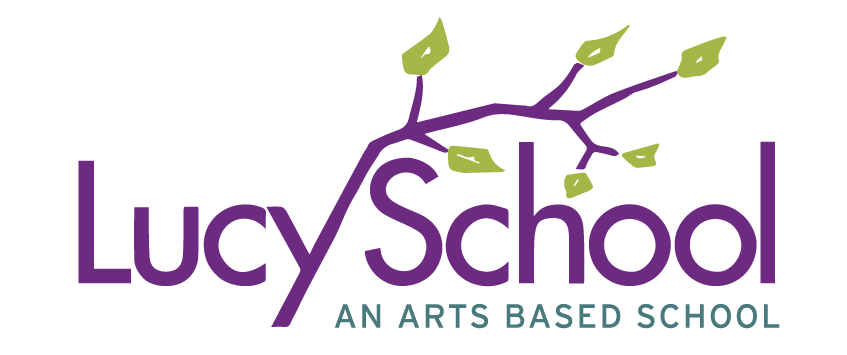
“Art is a line around your thoughts.”
-Gustav Klimt
The Arts build critical thinking, collaboration and communication, reasoning, creative problem-solving, and divergent thinking.
Students of all ages take classes in the Arts.
Teaching artists work with teachers to integrate drama, creative movement, dance, music, and visual arts into the curriculum.
Academic understanding is enhanced through artistic expression.
The Arts build critical thinking, collaboration and communication, reasoning, creative problem-solving, and divergent thinking.
All students take classes in the Arts, and classroom academics are enhanced through artistic expression. Teaching artists work with classroom teachers to integrate drama, creative movement, dance, music, and visual arts, providing enrichment and cross-curricular learning opportunities, and guest artists are brought in periodically to work with students.
-

Music and Movement
Lucy School’s music and movement philosophy stems from the belief that all humans have the innate ability to create. Rooted in the Reggio Emilia approach and the principles of Orff Schulwerk, Kolday, and Dalcroze Eurythmics, creativity, and imagination are highly encouraged in music and movement classrooms. Preschool and Elementary School students are introduced to body percussion and multi-cultural folk dances. Pitched and unpitched percussion, recorders, ukuleles, and pianos provide instrumental training. A formal Strings Program is offered by the 3rd grade with the introduction of the violin. Middle School students can participate in choral singing, musical theatre, audition technique classes, and dance. All students are encouraged to participate in various productions throughout the year. Private lessons in piano, violin, ukulele, and voice are also available after school. Teaching artists and classroom teachers collaborate to create integrated opportunities for class subjects and the arts throughout the year. Lucy School students are given the opportunity at each grade level to build vocal skills, rhythm concepts, movement techniques, and musical theory principles that sequentially build both skill and appreciation.
-

Visual Arts
The Reggio Emilia approach to education inspires the art studio at Lucy School in Pre-K through 2nd grade. This innovative and inspiring approach to early childhood education values the child as strong, capable, and resilient, rich with wonder and knowledge. We see that every child brings with them deep curiosity and potential, and this innate curiosity drives their interest to understand their world and their place within it. It is the role of the art teacher to activate the meaning-making of the children as a foundation for their art. We strive to offer a variety of ways that the children can express their understanding of themselves and the world around them. We believe that children use many different ways to show their understanding and express their thoughts and creativity. Some methods and materials we might use at Lucy School include drawing, sculpting, painting, printmaking, using loose parts or recycled materials, and integrating objects from the natural world: mud, leaves, ice, rocks, shells, and branches.
The art studio at Lucy School expands on this foundation, embracing the growth of creativity with an additional focus on technique. The students study their art and delve into deeper inquiries, grasping more advanced concepts. As students create, present, and respond to their art and the art of their peers, they make connections from other content areas, reflecting on broader themes. By incorporating interdisciplinary instruction with art materials at Lucy School, we facilitate the next level of knowledge. Middle school students take an integrated humanities/visual arts class each year, choosing from electives that include printmaking, design, drawing, painting, 3-D, and portfolio preparation. In these classes, the focus is on developing compositions using the fundamentals and principles of design that include line, shape, color, value, texture, balance, and harmony. The students work in a variety of media that include acrylic paint, watercolor, graphite, clay, and found objects.
-

Process Drama
Process drama is a dynamic teaching methodology in which the teacher and the students work together to create an imaginary dramatic world and work within that world to explore a particular problem, situation, theme, or series of related themes, not for a separate audience, but for the benefit of the participants themselves. In a process drama, students play a range of roles and engage in a variety of reflective out-of-role activities, requiring them to think beyond their own points of view and consider the topic from multiple perspectives. They emerge with an expanded self-awareness, and a greater sense of the challenges and the possibilities facing the society in which they live. Process drama also carries the potential for rigorous, standards-based learning to occur. It is used to initiate a learning experience; introduce and expose children to quality literature; foster socialization, collaboration and critical thinking skills; and to provide children with practice in language use and problem solving. Students not only explore the dynamics, relationships, and conflicts that shape a given situation, but also acquire factual knowledge related to the topic of the drama. Process drama is improvisational, there is no script, as in theatre. However, when process drama develops in harmony with the principles of theatre form, and when the spontaneous experience is not subverted by pressures of audience, end-product, or limited instrumental demands, it becomes possible for it to evolve into a significant dramatic event, as immediate, engaging and memorable as the best of any other kind of theatre.

